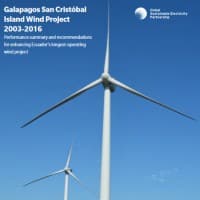A report on the Galapagos San Cristóbal Island Wind Project states the initiative has been a success, paving the way to further increasing renewable energy capacity in the region.
The Galapagos San Cristóbal Island Wind Project was inspired by an oil tanker incident in 2001 that saw approximately 150,000 gallons of fuel oil and diesel spilled in the pristine waters of the Galapagos Islands; one of the worst environmental disasters in the archipelago’s history.
To reduce reliance on diesel, three 800 kW wind turbines and three small solar panel systems were installed on San Cristóbal Island; which are supplying approximately 30% of the island’s electricity needs.
The renewable energy systems have produced 136,000 kWh of electricity to date; reducing diesel consumption by 2.3 million gallons and avoiding 21,000 tonnes of carbon dioxide emissions.
The availability of the wind park during eight years of operation was 92%; a good result given the remoteness of its location and available supporting infrastructure of the region. Only two significant events occurred during the period – one incident took a wind turbine offline for 80 days and another where one unit was offline for 23 days.
An important aspect of the project was environmental planning. The Galapagos Islands are home to many species, some of which are critically endangered; such as the Galapagos petrel. Close monitoring has determined that during the whole period of operation of the wind farm, no petrels have been adversely affected.
The project was developed through a partnership between the Government of the Republic of Ecuador and Global Sustainable Electricity Partnership (GSEP). The rollout, which cost an estimated USD $ 10 million, was funded primarily through a grant of funds from member companies of GSEP.
The report states it’s viable to increase renewables on the island to a point where they could economically meet 70% of electricity requirements. This would involve fully automating systems that control the diesel and wind generation, installing more solar panels, adding another wind turbine at the existing wind farm on El Tropezón hill and integrating battery storage.
“…the GSEP is proud that the Galapagos San Cristóbal Island Wind Project has been a pioneer in the use of wind energy resources in the region,” states part of a media release.
” This project is a model for replicability in the Galapagos Islands, Ecuador, South America, and worldwide and will continue to benefit the residents of San Cristóbal Island in the years to come.”
The full report can be viewed here (PDF).

















































